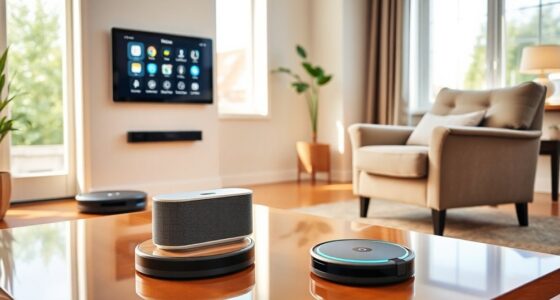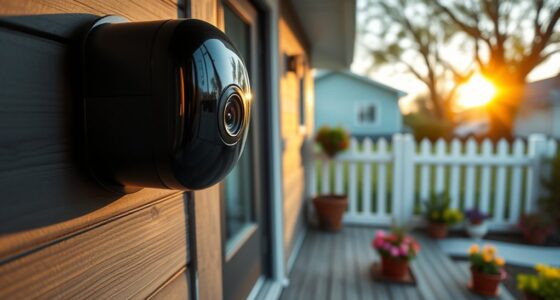Geofencing works by using sensors like GPS, Wi-Fi, or Bluetooth to create virtual boundaries around a physical area. When your device enters or exits these zones, automated actions, such as notifications or alerts, trigger based on your settings. It’s useful for marketing, security, or asset management, especially when precise location data helps you target specific activities. To discover how to set up and maximize geofencing, explore the key components and best practices outlined below.
Key Takeaways
- Geofencing uses sensor technology to detect device locations via GPS, Wi-Fi, Bluetooth, RFID, or cellular signals.
- Virtual boundaries are created with algorithms that compare device coordinates to predefined zones.
- It triggers actions like notifications or alerts when devices enter or exit specified areas.
- Common use cases include targeted marketing, security monitoring, asset management, and indoor navigation.
- Deployment requires careful planning, configuration, and consideration of privacy, cost, and environmental factors.
Understanding the Core Components of Geofencing
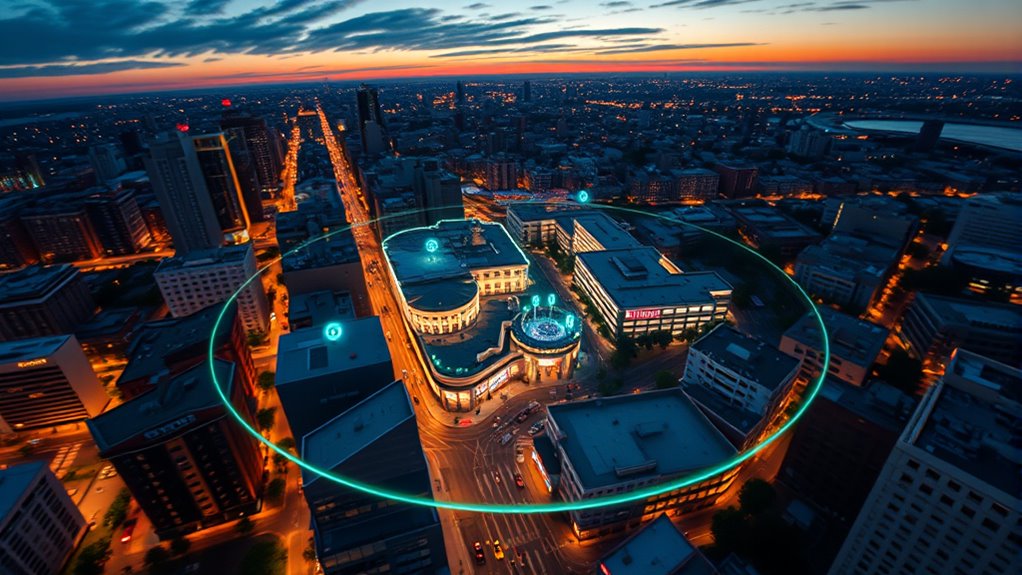
To understand how geofencing works, grasping its core components is essential. At the heart of it are sensor technology and boundary algorithms. Sensor technology detects your device’s location through GPS, Wi-Fi, or cellular signals, providing real-time data. Boundary algorithms then process this data to determine whether your device enters or exits a predefined area. These algorithms analyze geographic coordinates and compare them to established virtual boundaries, ensuring accurate detection. The sensors continually feed location updates, while the boundary algorithms interpret this information to trigger alerts or actions when boundaries are crossed. Additionally, reliable power sources are crucial for maintaining consistent system operation, especially during power outages. Together, these components form the foundation of effective geofencing systems, enabling precise monitoring and automation based on your device’s proximity to virtual boundaries.
The Technology Behind Virtual Boundaries
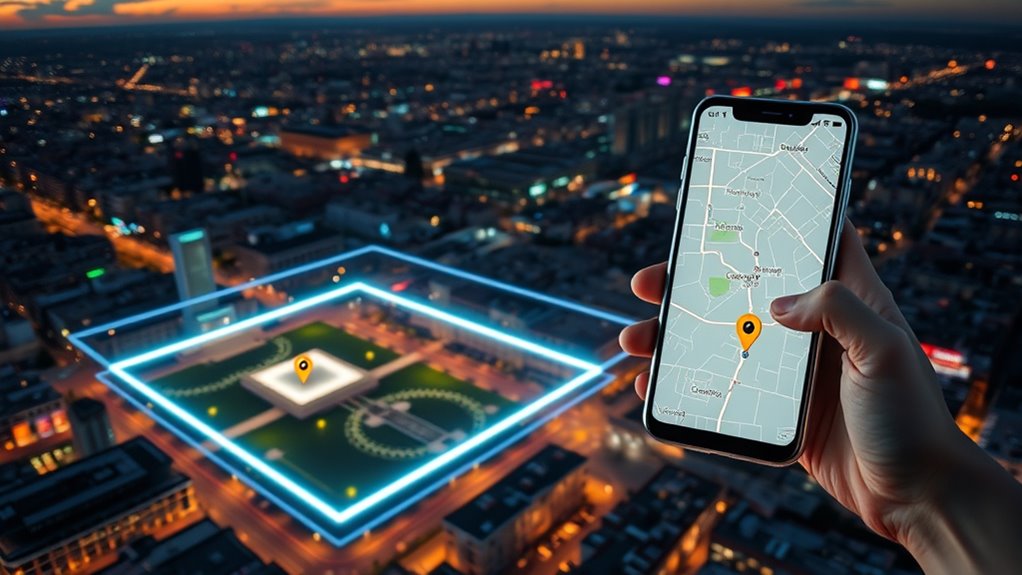
Virtual boundaries in geofencing rely on sophisticated algorithms that interpret location data to create precise perimeter zones. These algorithms process signals from GPS, Wi-Fi, Bluetooth, and RFID to establish virtual borders. Indoor positioning systems enhance this accuracy indoors where GPS falters, using technologies like beacons and sensors. Drones leverage these boundaries for navigation, avoiding restricted zones automatically. This seamless integration ensures safety and efficiency. Additionally, space optimization techniques help in designing effective geofence zones, minimizing overlap and gaps. Below is a table highlighting key technologies:
| Technology | Application | Limitation |
|---|---|---|
| GPS | Outdoor geofences | Signal loss indoors |
| Wi-Fi & Bluetooth | Indoor positioning | Short-range, interference |
| RFID & Beacons | Indoor navigation | Infrastructure setup needed |
| Ultrawideband | Precise indoor tracking | Costly, specialized hardware |
| Drone Sensors | Automated drone navigation | Limited to certain models |
Setting Up a Geofence: Step-by-Step Guide
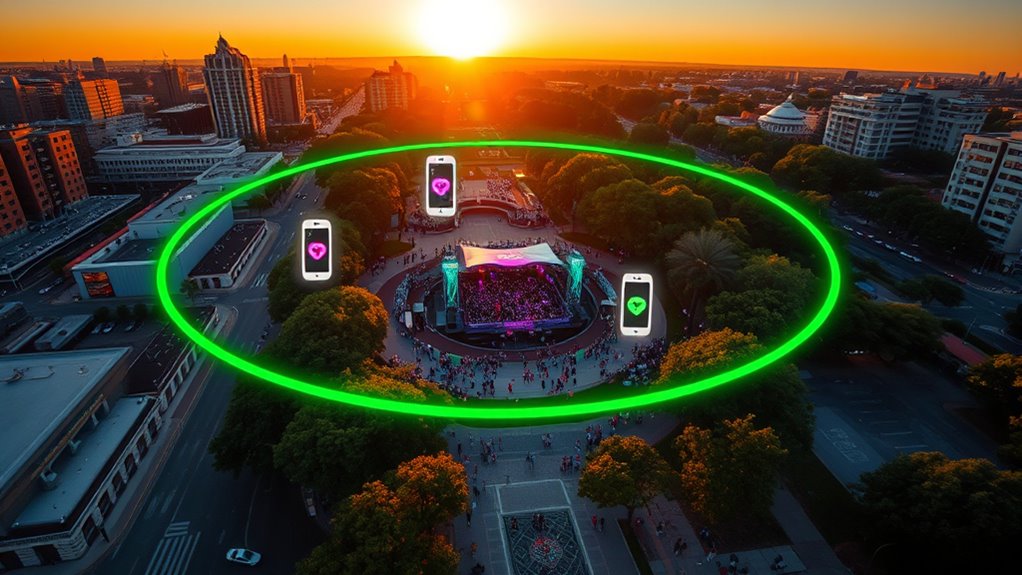
To establish a geofence, start by selecting the appropriate location that matches your goals. Next, configure the settings, such as radius and notifications, to suit your needs. These steps guarantee your virtual boundary functions accurately and effectively. Additionally, consider the type of terrain to ensure your setup aligns with the environment, much like choosing the right tires for a gravel bike.
Choosing the Right Location
Choosing the right location is essential for a successful geofence setup. Your goal is to select a spot that maximizes accuracy and effectiveness. Focus on landmark selection to ensure your geofence is easy to identify and consistent. Consider boundary precision to avoid overlaps or gaps that could lead to false triggers. Additionally, evaluating the surrounding environment, such as the physical space, can help optimize signal strength and reliability.
Configuring Geofence Settings
Once you’ve selected the ideal location for your geofence, it’s time to configure the settings to guarantee accurate monitoring. Start with geofence customization by defining the radius and shape that best fits your needs. Adjust notification settings to control when alerts are sent—such as entering, exiting, or dwelling within the area. Ensure notifications are clear and timely to maximize usefulness. Review all parameters carefully, including the geofence’s size and triggers, to avoid false alerts or missed events. Fine-tuning these settings helps you stay informed without overwhelming you with unnecessary notifications. Proper configuration guarantees your geofence functions reliably, giving you peace of mind and precise control over your monitoring. Additionally, understanding the importance of security system effectiveness can help you choose the right features for your security needs.
Types of Geofences and Their Specific Uses
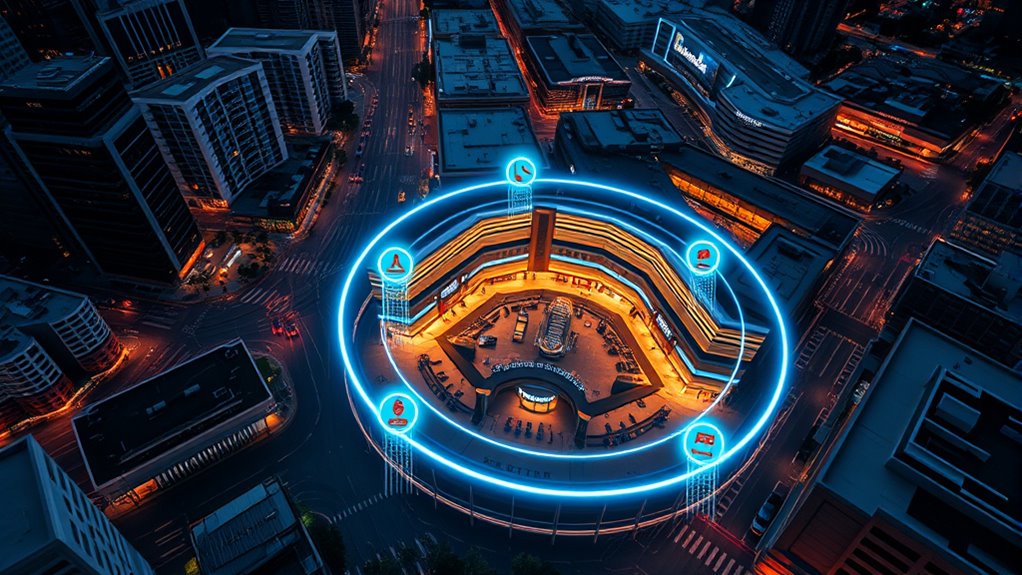
There are several types of geofences, each tailored to different needs and applications. You might use them for retail shopping, wildlife tracking, or other specific goals.
- Circular geofences: Ideal for retail stores or wildlife habitats, these are simple to set up and define a radius around a point.
- Polygonal geofences: These allow for more precise boundaries, perfect for complex retail layouts or tracking wildlife in irregular terrains.
- Tracking geofences: Used mainly for wildlife tracking, they monitor movement patterns and alert you when an animal enters or exits a designated area.
- Setting up organic and natural juices geofences can help businesses target customers near health food stores or juice bars for promotional offers.
Each type offers unique advantages, ensuring you can choose the right geofence for your specific use case, whether engaging customers or monitoring wildlife activity.
Applications in Marketing and Customer Engagement
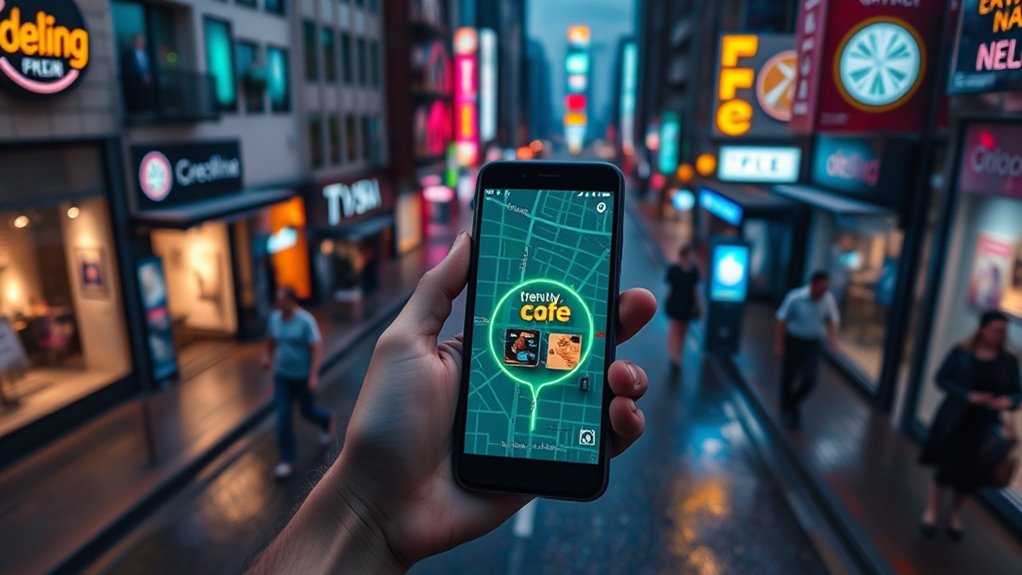
Have you ever wondered how businesses deliver personalized experiences to customers in real-time? Geofencing plays a key role by enabling targeted marketing based on your location. Brands use augmented reality to create immersive, interactive campaigns when you’re near their stores, making the experience memorable. Environmental sensors help companies gather data about the surroundings, allowing them to customize offers based on weather or noise levels. For example, a retailer might send a discount code when you’re nearby during a rainy day, encouraging foot traffic. With geofencing, you receive relevant promotions exactly when they matter most. This strategy enhances customer engagement by making interactions timely and tailored, ultimately increasing brand loyalty and sales. It’s a smart way for businesses to connect with you on a personal level and leverage Forsale 100 opportunities to promote their products effectively.
Security and Asset Management With Geofencing
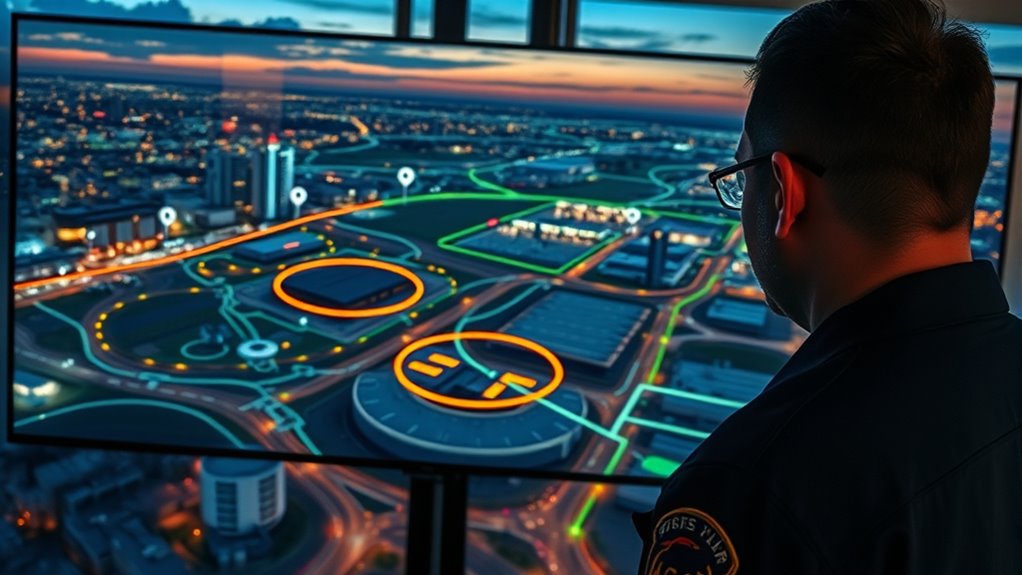
Geofencing extends beyond marketing to play a vital role in security and asset management. It helps you monitor physical assets, control access, and prevent theft. By setting virtual boundaries, you can receive alerts if devices leave designated areas, reducing cybersecurity threats and unauthorized access. Proper data encryption ensures sensitive information stays protected during these processes. With geofencing, you can:
- Track equipment location in real-time
- Limit access to secure zones
- Receive instant alerts for suspicious activity
This technology enhances your ability to safeguard assets, improve response times, and maintain operational integrity. By integrating geofencing with cybersecurity measures like data encryption, you strengthen your overall security infrastructure and better manage your assets. AI security solutions play a pivotal role in detecting and responding to threats within these systems.
Benefits and Limitations of Geofencing
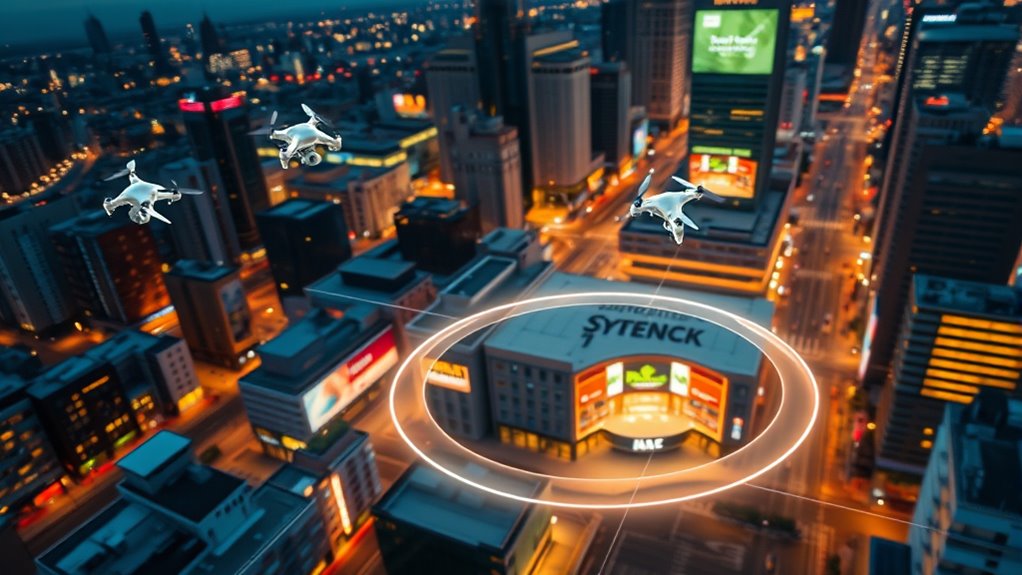
While geofencing offers significant benefits for security and asset management, it also has certain limitations that you should consider. Privacy concerns arise because it tracks location data, raising questions about user consent and data security. Additionally, the cost considerations for setup and maintenance can be substantial, especially for large areas or complex configurations. Here’s a quick overview:
| Benefit | Limitation | Key Consideration |
|---|---|---|
| Improves security | Privacy concerns | Ensure user consent |
| Enhances asset tracking | Cost for deployment | Budget accordingly |
| Automates marketing | False triggers | Fine-tune geofences |
| Increases engagement | Limited accuracy in some areas | Regular updates needed |
| Supports automation | Privacy and cost issues | Balance benefits with risks |
A thorough understanding of geofencing technology can help mitigate some of these challenges and maximize its effectiveness.
Best Practices for Effective Geofencing Deployment

To guarantee your geofencing implementation is effective, start by clearly defining your goals and target areas. Understanding user behavior helps tailor your campaigns and assures relevance. Leverage data analytics to monitor performance and refine your approach continuously. Focus on these best practices:
- Use precise geographic boundaries to avoid irrelevant notifications and improve user experience.
- Analyze data analytics regularly to identify patterns and optimize messaging based on user behavior.
- Test different strategies and refine your geofences to increase engagement and achieve your objectives.
- Incorporate pool terminology knowledge to ensure your geofence setup aligns with technical standards and safety considerations.
Future Trends and Innovations in Geofencing
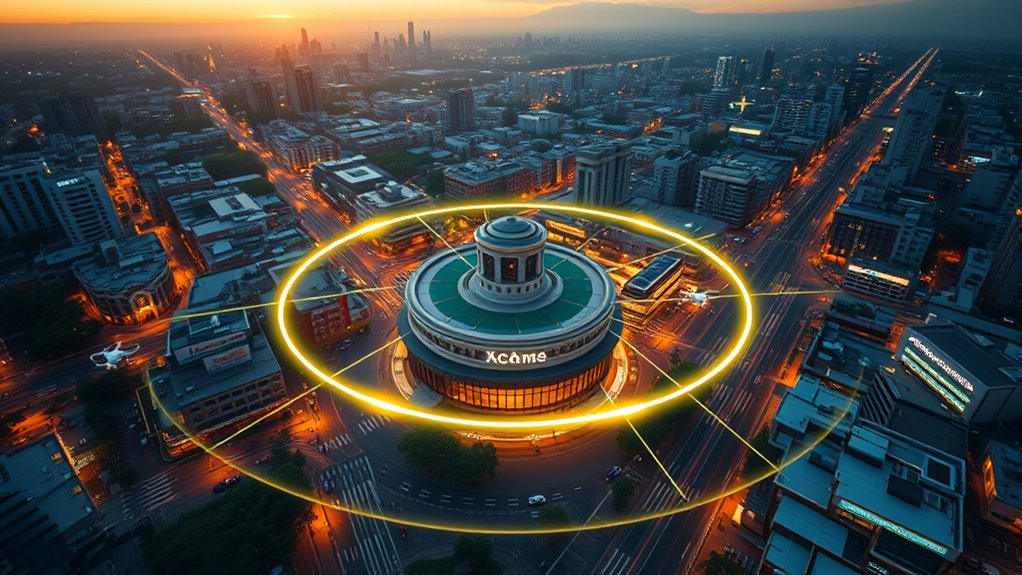
Advancements in AI are making geofencing smarter and more responsive to user behavior. You’ll also see improvements in location accuracy, allowing for more precise targeting. As these innovations grow, addressing privacy concerns and regulatory challenges will become even more essential.
AI Integration Advances
Artificial intelligence is driving a new wave of innovation in geofencing, enabling more precise and adaptive location-based services. AI-powered algorithms enhance indoor navigation, helping users find their way seamlessly within complex environments like malls or airports. They also optimize drone delivery routes, ensuring swift and accurate package drops. With AI, geofencing becomes smarter, adjusting boundaries dynamically based on real-time data. This allows for personalized marketing campaigns and improved security measures. You’ll see more integration of AI-driven insights that anticipate user needs and behaviors.
- Enhanced indoor navigation systems for better user experiences
- AI-optimized drone delivery for faster, more reliable service
- Adaptive geofences that evolve based on patterns and context
Enhanced Location Accuracy
As technology continues to evolve, improvements in location accuracy are set to revolutionize geofencing applications. You’ll find indoor navigation becomes more precise, allowing you to effortlessly navigate complex buildings like malls or airports. This enhanced accuracy also boosts location-based gaming, making virtual experiences feel more real and engaging. With better positioning methods, such as advanced sensors and hybrid systems, you can rely on geofencing for more targeted and seamless interactions. This means fewer errors and more reliable triggers when entering or leaving specific zones. As a result, businesses and developers can create smarter, more immersive experiences that respond precisely to your location, opening new possibilities for personalized marketing, entertainment, and operational efficiency.
Privacy and Regulation
With increasing adoption of geofencing technologies, privacy concerns and regulatory challenges are becoming more prominent. You need to prioritize data privacy and ensure regulatory compliance to build trust and avoid penalties. Future trends include stricter data privacy laws worldwide, requiring transparent data collection practices. Innovations may involve advanced encryption methods and user-controlled privacy settings to protect user information. Staying ahead means adopting secure data management strategies and understanding evolving regulations.
- Implement clear consent processes for location data collection.
- Use privacy-preserving technologies like anonymization.
- Regularly update policies to reflect new regulations and technological changes.
Frequently Asked Questions
How Accurate Is Geofencing in Different Environments?
Geofencing accuracy varies depending on the environment. You’ll find GPS accuracy is higher in open areas with a clear view of the sky, but signal interference from tall buildings or dense foliage can diminish precision. Indoors, GPS signals weaken, leading to less accurate geofencing. So, in urban or challenging environments, expect some margin of error, and plan your geofencing strategies accordingly to ensure reliable results.
Can Geofencing Work Without GPS or Internet?
You might wonder if geofencing can function without GPS or internet. The answer is, it’s limited—GPS limitations and offline tracking hinder its effectiveness. Without real-time data, geofencing can’t precisely detect entry or exit, especially indoors or in remote areas. While some solutions attempt offline tracking, they lack the accuracy and immediacy you need. So, yes, it can work, but expect significant restrictions without active GPS or internet connections.
What Are the Legal Privacy Concerns With Geofencing?
You should be aware that geofencing raises privacy concerns because it involves tracking user locations. To address this, always get user consent before implementing geofencing features, ensuring transparency about how data is collected and used. Without proper consent, you risk legal issues and damage your reputation. Respecting privacy concerns and obtaining clear user approval helps you maintain trust and stay compliant with privacy regulations.
How Does Geofencing Impact User Consent and Data Security?
You need to be aware that geofencing directly impacts user privacy and data security, so you can’t afford to take it lightly. When users are informed and give explicit consent, it helps build trust and ensures compliance. However, mishandling data security can lead to breaches or misuse of personal information. Always prioritize transparent communication and robust security measures—it’s a case of having your cake and eating it too.
Are There Industry-Specific Regulations for Geofencing Usage?
Yes, there are industry-specific regulations and compliance standards you need to follow when using geofencing. For example, healthcare and finance sectors have strict rules about data privacy, requiring you to secure user consent and safeguard personal information. Retail and advertising industries also face regulations around transparency and advertising practices. Staying informed about these standards helps you avoid legal issues and ensures responsible geofencing implementation aligned with industry regulations.
Conclusion
Now that you understand how geofencing works and when to use it, you’re equipped to harness its power like a digital superhero. With smart setup and strategic application, you can transform customer engagement, security, and automation. Don’t underestimate its potential—it’s not just a tool but a game-changer that can revolutionize how you connect with the world around you. Embrace geofencing, and watch your opportunities multiply faster than you ever imagined.




